Houston, Do We Have an Animal Trapping Problem? The Trapping Debate Explained
By Kayla Meyertons
Reporting Texas
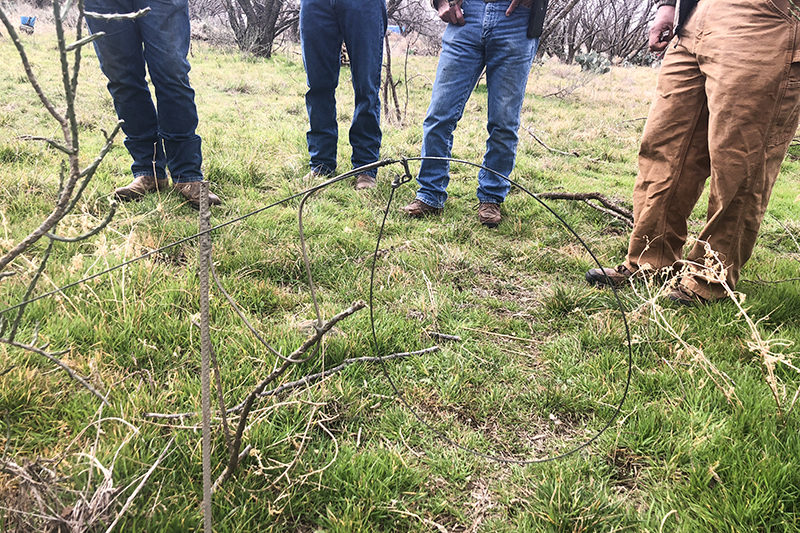
Trappers stand behind a snare at a Texas Trappers and Fur Hunters Association meeting in February in Moran. Kayla Meyertons/Reporting Texas.
This story has been updated.
Dogs barked in the background. Cowboy boots scraped the earth. One wrong move, and a trap could snap, but weathered hands moved with confidence.
On a cool Saturday morning in February, roughly 30 members of the Texas Trappers and Fur Hunters Association met at a property in Moran, Texas to give demonstrations, answer questions and educate fellow trappers and the public on proper trapping techniques.
“I couldn’t make it locked up in an office somewhere 10 hours a day,” Beaver trapper Keith Jackson said. “I just enjoy being outside.”
A love for nature and the call of the wild are why members of this 39-year-old trapping club have committed their lives to the practice.
In Texas, trapping is mainly used to control predators and nuisance animals that threaten livestock, which is part of an agriculture industry with an economic impact of more than $100 billion annually, according to the Texas Department of Agriculture. The practice churns up heated debate between trappers, hunters, ranchers who are at risk of losing livestock and animal welfare groups.
The state regulates trapping under the auspices of the Texas Parks & Wildlife Department. Trappers must have a standard hunting license and a property owner’s consent to set traps. Trapping furbearer species such as foxes and beavers requires an additional license. Those species have harvest seasons and possession limits, but for nongame species such as mountain lions, bobcats and coyotes, there are no harvest regulations.
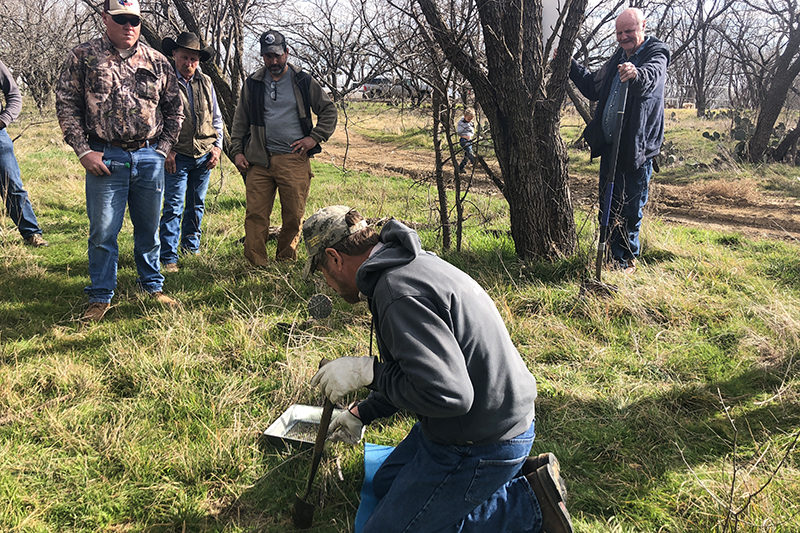
Texas Trappers and Fur Hunters Association members watch coyote trapper Dan Hepker set a trap. Kayla Meyertons/Reporting Texas
Trapping has long been used as a means to control destructive animal populations by removing excess animals. Nuisance species such as beavers can cause millions of dollars of property damage to ranches in East Texas. Mountain lions can devastate West Texas wildlife and livestock herds. And a lone coyote can kill and eat pets in the Austin suburbs.
“It’s not always an easy job,” Bastrop-based coyote trapper Dan Hepker said. “You have to kill animals [… and] people don’t actually see in the wild what’s going on [or] the damage that these animals do.”
Not everyone agrees. The Humane Society of the United States considers recreational hunting and trapping to be “cruel, inhumane and egregious,” said Gabe Wigtil, a wildlife protection manager for the society.
“It is not a way to resolve conflict with animals,” Wigtil said. “There are problems and suffering that are not necessarily caused by the trap itself but because they have been trapped, [which is] why trapping is extremely cruel.”
By definition, animal trapping is the use of a device to capture an animal. Foothold traps snap shut with the help of coil springs and catch the animals by paw or foot. Snares catch animal by the leg or neck with a noose made of wire. Professional trappers typically use foothold traps with offset jaws or rubber inserts to avoid breaking the animal’s skin.
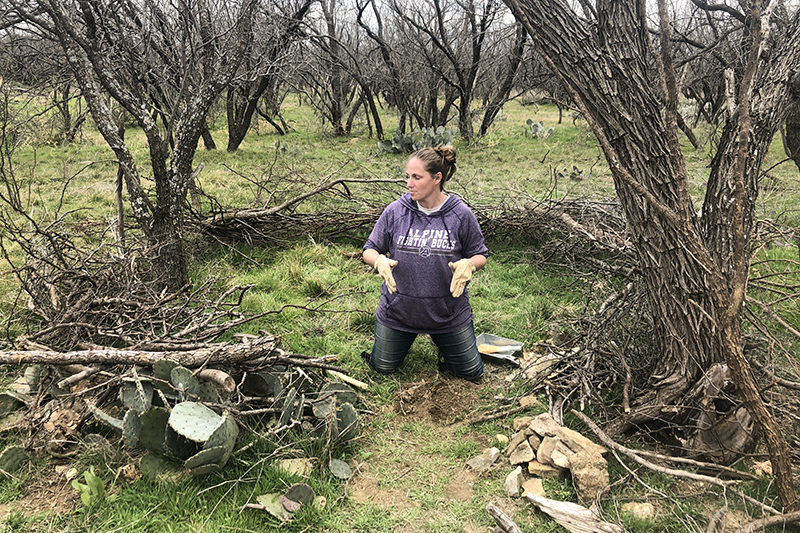
Hollee Applegate demonstrates how to set a lion trap. Kayla Meyertons/Reporting Texas
During the demonstrations at the Texas Trappers workshop in February, each trapper set their traps or snares carefully and specific to the target animal.
“It’s not designed to cut the foot off,” Jackson said. “If we catch an animal and he breaks his foot and goes off three legged, we haven’t gained anything.”
State law requires trappers to check traps for furbearer species such as beavers every 36 hours. For nongame species, this regulation does not apply. Wigtil argued animals may die cruel deaths from starvation, blood loss, dehydration, hypothermia or another predator before the trappers dispatch them. Traps can also capture dogs, birds or other non-target animals, Wigtil said.
“No trap is foolproof. Any trap can tear flesh, cut tendons, ligaments or break bones,” Wigtil added.
Based in Marfa, Bill Applegate is perhaps the most well-known mountain lion trapper in Texas. He has trapped across thousands of acres in West Texas properties and the Trans-Pecos region for the last 50 years and has a reputation among his peers for catching the most mountain lions each year. He said he couldn’t refute Wigtil’s claim about some pain caused to animals trying to escape from traps. However, he says this discomfort is for a shorter duration and experienced by fewer animals than the widespread suffering caused by disease and starvation due to overpopulation.
“If you do away with trapping just to ensure a few animals are not going to suffer then you are … wide open to hundreds of thousands of animals dying from pain and starvation and disease,” Applegate said. “To me that is much crueler than using a trap.”
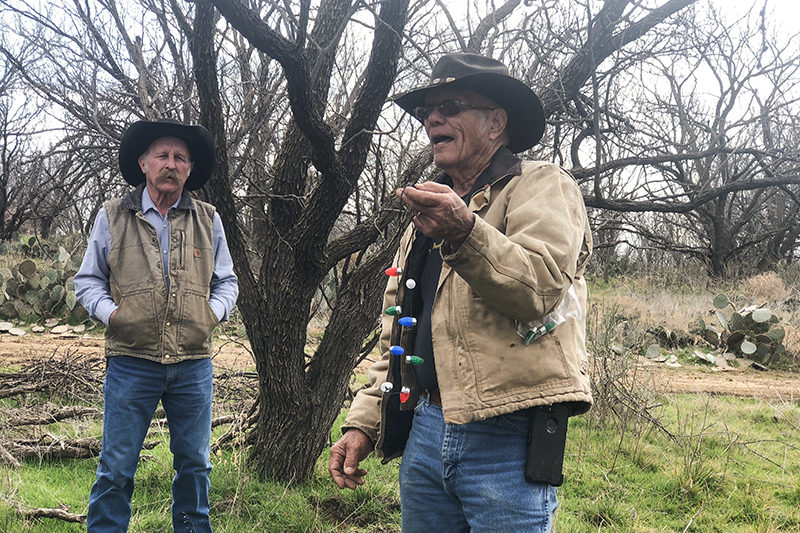
Bobcat Trapper Jim Brooks, left, speaks at a Texas Trappers and Fur Hunters Association meet up. Kayla Meyertons/Reporting Texas
Trappers can’t eliminate non-target catches completely, Applegate said. But with improved training, equipment and experience, they can minimize discomfort. “A trapper does not want to see an animal suffer because then it is going to make greater efforts to escape and a trapper does not want to come up with an empty trap,” he said.
Most trappers operate independently and are hired by private landowners to manage nuisance animals.
In Cherokee County, Jackson uses body grip traps to kill beavers instantaneously or grounding rigs to drown them in river banks. At the February workshop, Hepker demonstrated setting a coyote trap. He dug a 6-inch diameter hole, opened the trap’s coil springs and placed the trap in the hole before covering it lightly with dirt and animal scents. Trapper Jim Brooks based in Menard County tied a Christmas ornament to a bush to show how to attract bobcats. Other members tied snares to tree limbs and bushes.
“I’ve caught thousands of animals. I believe that when a wild animal steps into a trap that puts the animal into a state of shock … and they will not have the pain you might imagine,” Applegate said. “Shock is Mother Nature’s pain medicine. As shock wears off, the paw becomes numb,” he added.
Jackson said he has trapped beavers with infected, pus-filled holes in their bodies or hunks out of their tails from fighting with each other.
“If there’s overpopulation, it’s not good at all,” Jackson said. “The method Mother Nature uses to control that population is a lot worse on them than what we do.”
Hepker said overpopulation can spread mange and force coyotes to feed on livestock, “Last year I caught so many coyotes with really bad mange, hardly any hair and little mites running all over their fur,” he said. “I’m doing it a favor.”

Bill Applegate holds a lion trap. Kayla Meyertons/Reporting Texas
The Humane Society favors nonlethal methods to protect livestock from predators. These methods, proven effective in scientific literature, include building electric fencing, using guard animals, immediately removing dead livestock and scaring off predators with auditory and visual deterrence, such as radio alarm boxes, spot lights and air horns.
“You’re just creating a problem for yourself by not [using nonlethal means] to protect livestock,” said Haley Stewart, a wildlife protection manager for the Humane Society’s native carnivore protection campaign. “That’s not always an option for everybody, but in smaller-scale operations keeping animals in enclosed pens during the evening when carnivores are out is the most effective strategy.”
At the same time, there’s a reason these nonlethal methods might not work. In West Texas where Applegate traps, some ranches span thousands of acres, making it impossible to pen up herds every night and install noises and lights.
“Can you imagine what the world would sound like?” Applegate said. “That’s ridiculous … [and] predators learn to adapt because their job is hunting to figure out how to kill. Anytime there is a deterrent put in their path they find a way to get around it.”
In Texas, studies show significant amounts of habitat and prey for predators, The Humane Society’s Stewart said. And some animals, such as mountain lions and coyotes, organize themselves in social hierarchies, so when a trapper removes an adult male, inexperienced younger males may come in and kill more livestock, defeating the purpose of trapping, she added.
“These animals can live very healthy in Texas, and they don’t need to be trapped to keep them from starving,” Stewart said. “That’s just not a scientifically sound argument.”
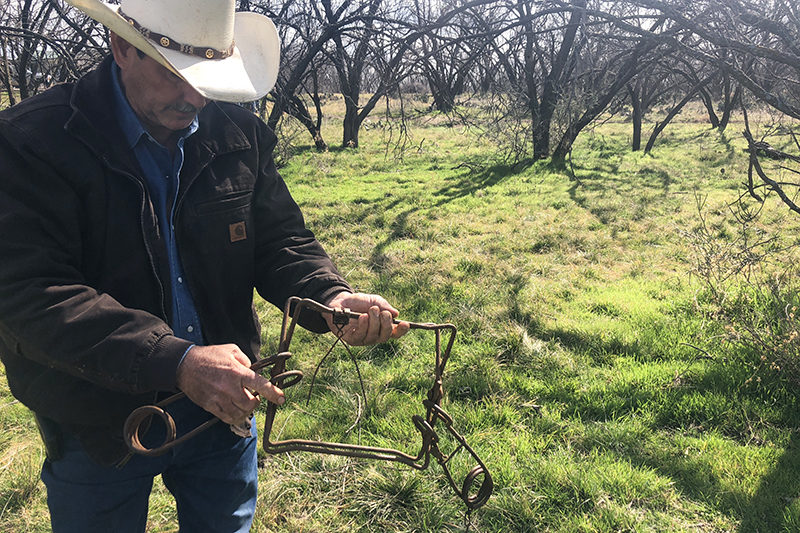
Beaver trapper Keith Jackson holds a beaver body grip trap. Kayla Meyertons/Reporting Texas
In the paradox of killing animals for a living, trappers and hunters contribute to wildlife conservation. Hunters in the United States have contributed over $5.5 billion for wildlife conservation during the last 60 years, according to the Texas Parks & Wildlife Department website.
Federal taxes on hunting and fishing gear fund wildlife management and habitat restoration around the nation. These programs have provided more than $650 million to Texas Parks & Wildlife Department and $300 million for wildlife research and conservation in Texas.
At the core of the trapping debate in the Lone Star state is the fact that Texas is one of the most rapidly urbanizing states in the nation. Finding better ways to coexist with wildlife is likely to become a growing priority as cities encroach on more wild habitats.
“If we just get out of the picture then we can leave them alone, but people have got to come first before animals,” Applegate said. “People are going to do what it takes to be the last creature on Earth … That’s just human nature.”
Stewart says that many trappers care about wildlife, but at the end of the day, unregulated killing of wild animals is detrimental.
“The question would be do they recognize that and are they willing to allow for some sort of regulation,” Stewart said. “That’s a conversation we would be open to having.”
An earlier version of this story incorrectly stated members of the Texas Trappers and Fur Hunters Association met at a property in Bastrop in February. The error has been corrected.